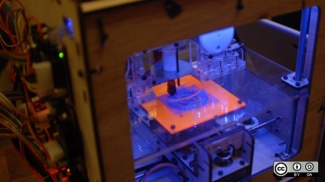
I first encountered 3-D printing in Cory Doctorow’s Makers, a science fiction novel set in the wake of economic armageddon. In Doctorow’s imagined near-future world, hulking industrial bulwarks are doomed. Malls are deserted. But garages are alight with innovative activity, as heroic, entrepreneurial inventor-doers concoct new gizmos by repurposing abandoned commodities.
And at the center of the novel—the object of so much conflict and controversy—is the 3-D printer, a technology relatively obscure at the time of Doctorow’s writing. Last week, NPR reported that 3-D printing is coming into its own. As Jon Kalish weaves a narrative about the potential for “digital fabrication machines” to democratize production, disrupt the traditional factory model, and create goods on smaller scales, he doesn’t speak long before invoking open source.
Digital fabrication involves manufacturing, or “printing,” three-dimensional objects from a variety of materials, including wood, metal, and plastic. So-called 3-D printers can read designs stored in digital files and translate them into solid matter on the spot.

